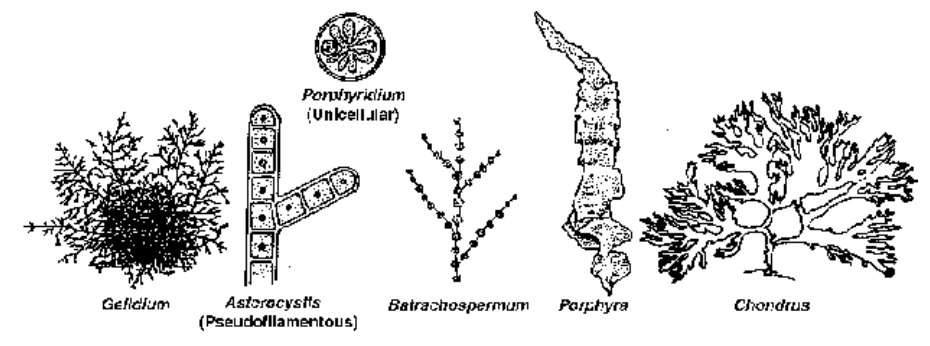Thallophyta–Algae
Plant Kingdom of Class 11
About Thallophyta–Algae
Algae and fungi (In Five Kingdom System, Fungi have their own Kingdom, Fungi) are considered together in thallophyta (having undifferentiated plant body), though there is basic difference in the mode of nutrition (i.e., autotrophic in algae and heterotrophic in fingi).
The term algae (L. alga – sea weed) was first introduced by Linnaeus (1755) but the present day algae were delimited by de Jussieu (1789).
Characteristics of Algae
Algae usually occur in a variety of habitats such as water, land as well as on the other plants and even animals. Some grow in marine water called seaweeds.
Plant body is unicellular, colonial, filamentous, parenchymatous or pseudoparenchymatous.
Vascular tissues are absent.
A mechanical tissue is absent.
Nutrition is autotrophic.
A variety of pigments in algae provide different colours.
Vegetative and asexual modes of reproduction are abundant.
Sexual reproduction involves isogamy, anisogamy and oogamy. Sex organs are unicellular and non-jacketed.
An embryo stage is absent.
Life cycle is various–haplontic, diplontic or diplohaplontic.
Classification of Algae
Algae are usually differentiated on the basis of their pigments and storage products (see table). Algae included under kingdom Plantae by Whittaker (1969) are of three types : red algae, brown algae and green algae.
A detailed classification of Algae is given by F.E. Fritsch in his book ‘Structure and Reproduction in Algae’.
Rhodophyceae : Red Algae
Red algae are an ancient group of algae with over 5,000 living species.
They are marine except for a few fresh water species, e.g. Batrachospermum.
Red algae are autotropic with the exception of a few like Harveyella. It is colourless and parasitic on other red algae.
A motile or flagellate stage is completely absent.
The plant body varies from unicellular to multicellular forms.
Cell wall possesses cellulose, pectic compounds and certain mucopolysaccharides called phycocolloids. The latter are usually sulphated. The important phycocolloids of red algae are agar, carrageenin and funori. The photosynthetic organelles are called chromatophores. They have single thylakoid.
Photosynthetic pigments include chlorophyll a, carotenoids and phycobilins. Chlorophyll d has been reported in some cases. Phycobilins are of two types, red coloured phycoerythrin and blue coloured phycocyanin.

Fig. : Some red algae
The red colour of red algae is due to abundant formation of phycoerythrin.
Reserve food is floridean starch. In constitution, it is very much similar to glycogen.
Vegetative reproduction takes place by fragmentation, gemmae, and regeneration of holdfast.
Asexual reproduction takes place through a variety of spores.
Sexual reproduction is an advanced type of oogamy. The male sex organ is called spermatangium or antheridium. It produces non flagellate male gamete known as spermatium. The female sex organ is flask shaped and is termed carpogonium.









